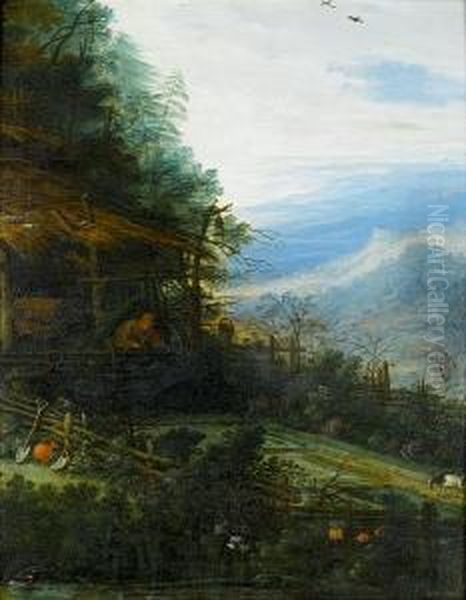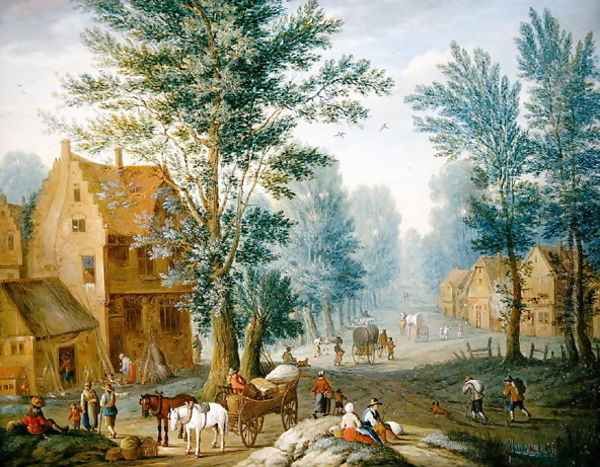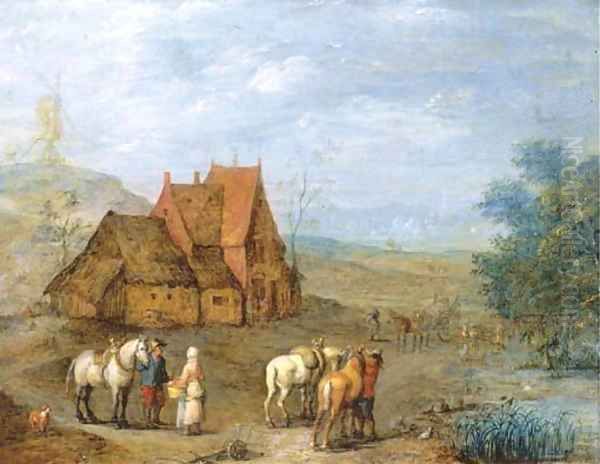Joseph van Bredael stands as a significant figure in the lineage of Flemish landscape painting, an artist whose career bridged the late Baroque and emerging Rococo sensibilities of the early 18th century. Born in the bustling artistic hub of Antwerp in 1688 and passing away in Paris in 1739, Van Bredael carved a niche for himself through his meticulous and charming depictions of rural life, heavily inspired by the enduring legacy of the Bruegel dynasty. His success extended beyond Flanders, most notably finding favour in the competitive art world of Paris, where he achieved prestigious appointments and recognition.
Antwerp Origins and Artistic Formation
Joseph van Bredael entered the world in Antwerp, a city with an unparalleled artistic heritage. By the late 17th century, while the absolute zenith of painters like Peter Paul Rubens and Anthony van Dyck had passed, Antwerp remained a vital centre for art production and training, steeped in the traditions of the Guild of Saint Luke. Joseph was born into an artistic family; his father was Joris van Bredael, also a painter, ensuring Joseph was immersed in the craft from a young age. This familial connection likely provided his initial training and access to the techniques and styles prevalent in the region.
The artistic environment of Antwerp during Van Bredael's formative years was still deeply influenced by the masters of the previous century. The detailed realism, vibrant colours, and diverse subject matter championed by artists like Rubens, Van Dyck, and Jacob Jordaens formed the bedrock of Flemish painting. However, the specific genre of landscape and peasant scenes, popularized by Pieter Bruegel the Elder and refined by his sons, particularly Jan Brueghel the Elder, held a special and enduring appeal. It was this Bruegelian tradition that would most profoundly shape Joseph van Bredael's artistic path. He reportedly began painting seriously around the age of 18, quickly demonstrating a remarkable talent for capturing the essence of these established styles.
Relocation to Paris and Professional Success

While rooted in Antwerp, Joseph van Bredael's career took a decisive turn when he moved to Paris. The French capital, under the reign of Louis XIV and later during the Régence, was the undisputed cultural epicentre of Europe. It offered artists opportunities for patronage and prestige perhaps unavailable elsewhere. Van Bredael successfully navigated this demanding environment, achieving significant recognition.
A major milestone in his Parisian career was his appointment as a court painter to Philippe II, Duke of Orléans. The Duke, who served as Regent of France from 1715 to 1723, was one of the most important art collectors and patrons of his time, amassing a legendary collection housed at the Palais-Royal. To be appointed as a painter to such a figure was a considerable honour, indicating Van Bredael's high standing and the appeal of his Flemish style to French aristocratic tastes. This position would have provided him with financial stability and access to influential circles.
Further cementing his status within the Parisian art establishment, Joseph van Bredael was accepted into the prestigious Académie Royale de Peinture et de Sculpture (often referred to simply as the Académie des Beaux-Arts in later contexts). Membership in the Academy was the highest official recognition an artist could achieve in France, granting exhibition privileges at the Salon and confirming their mastery. His acceptance signifies that his skills, particularly his proficiency in the established landscape tradition, were highly valued by his peers and the Academy's leadership. He spent a significant part of his professional life in Paris, ultimately passing away there in 1739.
Artistic Style: Echoes of Bruegel
The defining characteristic of Joseph van Bredael's art is his deep engagement with the style of the Bruegel family, particularly Jan Brueghel the Elder, known as 'Velvet' Bruegel for his smooth finish and rich detail. Van Bredael was not merely influenced by the Bruegels; he became renowned as a highly skilled imitator of their work. This was not necessarily seen negatively at the time; mastering and replicating the style of esteemed predecessors was a common practice and a demonstration of technical prowess.
His paintings typically feature panoramic landscapes populated with numerous small figures engaged in various activities. Following the Bruegelian model, he depicted village festivals (kermesses), bustling markets (including specific mentions of cattle markets), travellers on country roads, and expansive river or coastal views. These scenes are rendered with meticulous attention to detail, capturing the textures of foliage, the architecture of village houses, and the varied attire of the figures.

Van Bredael adopted the high viewpoint often employed by Pieter Bruegel the Elder and Jan Brueghel the Elder, allowing for a broad vista and the inclusion of multiple narrative vignettes within a single composition. His brushwork is consistently fine and controlled, contributing to the detailed finish reminiscent of 'Velvet' Brueghel. A particularly noted feature of his style is his use of colour, often incorporating distinct and delicate blue tones, especially in skies and distant landscapes, which lent his work a specific atmospheric quality and vibrancy, making the scenes of everyday life appear lively and charming.
Themes and Subject Matter
Van Bredael's oeuvre primarily revolves around landscape and genre scenes, celebrating the rhythms of rural and village life. He excelled in capturing the communal energy of peasant gatherings. His market scenes teem with activity – merchants displaying their wares, customers inspecting goods, horse-drawn carts navigating crowded squares, and livestock being traded. These compositions are rich in anecdotal detail, offering glimpses into the social and economic life of the period.
Village scenes are another cornerstone of his work. These might depict tranquil moments by a river, figures conversing near cottages, or larger communal events set against a backdrop of windmills and church spires. Works like the documented Village Scene with Merchants, Horse-Drawn Carts and Windmills exemplify this aspect of his production, showcasing his ability to orchestrate complex compositions filled with incident while maintaining an overall sense of harmony.
Landscapes, both real and imagined, provided the settings for these activities. He painted flatter Flemish countryside scenes but also incorporated more dramatic, mountainous elements, sometimes described as Italianate, reflecting a broader trend in landscape painting. The painting titled A Mountainous Landscape with a Figure Reading Before a Cottage indicates this diversity. His work Travelers focuses on figures journeying through the landscape, often featuring rivers or pathways leading the viewer's eye into the distance, a common compositional device in Flemish landscape tradition established by artists like Joos de Momper.
Technique and Palette
Joseph van Bredael's technical skill was central to his success, particularly his ability to replicate the refined finish associated with Jan Brueghel the Elder. His application of paint was typically smooth, with fine brushes used to render minute details in figures, foliage, and architecture. This meticulousness gives his paintings a jewel-like quality, inviting close inspection.

His palette, while varied, is often highlighted by the characteristic use of blues. These blues appear not only in skies and water but often permeate the mid-grounds and backgrounds, creating atmospheric perspective and unifying the composition. This prevalence of blue tones became something of a signature, contributing to the fresh and lively feel noted by observers. He effectively used colour to differentiate planes within the landscape and to highlight key figures or groups within the bustling scenes. The overall effect was one of clarity, charm, and intricate detail, breathing life into the traditional Flemish landscape formula.
Context: Contemporaries and Influences
Van Bredael operated within a rich artistic context, inheriting traditions and working alongside contemporaries who shaped the art of the early 18th century. His primary influences are clear: Pieter Bruegel the Elder, the originator of the peasant genre and panoramic landscape style, and his son Jan Brueghel the Elder, whose detailed, colourful, and often collaborative works set a standard for Flemish painting. The legacy continued with Jan Brueghel the Younger, further embedding this style. Van Bredael's work is a direct continuation of this specific lineage.
Within the broader Flemish context, although active later, he worked in the shadow of giants like Peter Paul Rubens and Anthony van Dyck, whose dynamic Baroque style had defined Antwerp's golden age. While Van Bredael's style was less dramatic, the emphasis on vibrant life and technical mastery echoes the high standards set by these predecessors. Closer in time and subject matter was David Teniers the Younger, another highly successful painter of peasant scenes and kermesses, though Teniers often brought a more direct, sometimes humorous observation to his figures compared to Van Bredael's more decorative approach.
In Paris, Van Bredael would have been aware of, and perhaps interacted with, leading figures of the French school. Antoine Watteau, a near contemporary, was revolutionizing painting with his fêtes galantes, scenes of aristocratic leisure imbued with a poetic melancholy. While stylistically different, both artists catered to patrons interested in charming, elegantly executed scenes. Other French contemporaries included Jean-Baptiste Oudry, known for his animal paintings and still lifes, who also enjoyed court patronage. Later Rococo masters like François Boucher and Jean-Honoré Fragonard would further develop the taste for decorative, lighthearted themes that Van Bredael's pleasing landscapes perhaps helped to foster among Parisian collectors.
A specific, though somewhat unclear, connection exists with Ferdinand-Joseph Godefroid. Records suggest Van Bredael was involved in assessing or inventorying works, possibly related to the Godefroid family, who were known in Paris not only for music (Felix Godefroid, the harpist) but also potentially in art dealing or restoration circles. This hints at Van Bredael's integration into the practical side of the Parisian art world, beyond just painting.
Distribution of Works and Market Recognition
The enduring appeal of Joseph van Bredael's work is evidenced by the presence of his paintings in numerous public collections across Europe and North America. Museums in cities such as Amsterdam, Antwerp (his birthplace), Basel, Blois, Brussels, Dresden, Detroit, Geneva, Lucerne, and Vienna hold examples of his art. This wide distribution underscores his historical importance and the recognition of his skill by curators and collectors over the centuries. The inclusion of his works in such prominent institutions allows for continued study and appreciation of his contribution to Flemish landscape painting.
Beyond museum collections, Van Bredael's paintings have consistently appeared on the art market, indicating sustained interest from private collectors. Auction records provide concrete examples of this market presence. For instance, in October 2013, Christie's in London offered A Mountainous Landscape with a Figure Reading Before a Cottage with an estimate of £2,000-£3,000 (though the final price achieved in the provided text is £4,000-£6,000, suggesting either a different sale or a typo in the source - auction results should be verified). Another sale at Bonhams Knightsbridge in London on November 2, 2016, featured Travelers, a small panel estimated at £3,000-£5,000, and another work titled The Circle estimated at £1,500-£2,500.
An earlier significant transaction mentioned is the acquisition of a work by the Metropolitan Museum of Art in New York in June 1982 for $19,000. While this is a museum purchase rather than a typical auction result reflecting private market trends, it demonstrates the high regard in which his work was held by major institutions even decades ago. The continued sale of his works at international auction houses confirms his status as a collectible Old Master whose detailed and charming scenes retain their appeal.
Legacy and Art Historical Significance
Joseph van Bredael occupies a specific and important place in the history of Flemish art. He is primarily recognized as one of the most skilled and dedicated followers of the Bruegel tradition in the 18th century. At a time when artistic styles were shifting towards the lighter, more decorative Rococo, Van Bredael helped to keep the detailed, narrative-rich landscape genre alive and relevant, particularly for patrons who appreciated its established charm and technical demands.
His success in Paris is noteworthy. By gaining favour with the Duke of Orléans and acceptance into the French Academy, he demonstrated that the Flemish landscape style, particularly the Bruegelian variant, could transcend borders and find appreciation within the sophisticated Parisian art market. He served as a conduit, bringing a specific Flemish aesthetic to the heart of French cultural life.
While perhaps not a major innovator in the vein of the Bruegels themselves or the leading French Rococo painters, Van Bredael's contribution lies in his mastery of a received style and his ability to infuse it with consistent quality and charm. His characteristic use of blue tones and his meticulous rendering of bustling scenes created a recognizable and appealing body of work. He represents a successful adaptation of a late Baroque Flemish tradition to the tastes of the early 18th century, ensuring the continued appreciation of detailed genre landscapes.
Conclusion
Joseph van Bredael remains a respected figure within the study of Flemish Old Master painting. His life and career illustrate the enduring power of artistic tradition, particularly the legacy of the Bruegel family, and the possibilities for artists who could skillfully adapt these traditions for new audiences and contexts. Born in Antwerp and finding fame in Paris, he excelled in creating finely detailed, lively, and atmospheric landscapes and village scenes that captured the imagination of patrons like the Duke of Orléans and earned him a place in the French Academy. His works, characterized by their meticulous finish, charming subject matter, and distinctive blue palette, continue to be appreciated in museums and private collections worldwide, securing his position as a significant master of the 18th-century Flemish school.